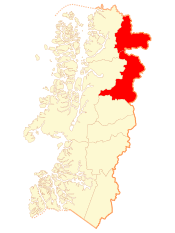Coyhaique Province
| Coyhaique Province Provincia de Coyhaique | ||
|---|---|---|
| Province | ||
| ||
 Location in the Aysén del General Carlos Ibáñez del Campo Region | ||
 Coyhaique Province Location in Chile | ||
| Coordinates: 45°00′S 72°00′W / 45.000°S 72.000°WCoordinates: 45°00′S 72°00′W / 45.000°S 72.000°W | ||
| Country | Chile | |
| Region | Aisén | |
| Capital | Coyhaique | |
| Communes |
Coyhaique Lago Verde | |
| Government[1] | ||
| • Type | Provincial | |
| • Governor | Néstor Mera Muñoz | |
| Area[2] | ||
| • Total | 12,942.5 km2 (4,997.1 sq mi) | |
| Population (2012 Census)[2] | ||
| • Total | 54,575 | |
| • Density | 4.2/km2 (11/sq mi) | |
| • Urban | 44,850 | |
| • Rural | 6,253 | |
| Sex[2] | ||
| • Men | 26,108 | |
| • Women | 24,995 | |
| Time zone | CLT [3] (UTC-4) | |
| • Summer (DST) | CLST [4] (UTC-3) | |
| Website | Government of Coyhaique | |
Coyhaique Province (Spanish: Provincia de Coyhaique) is one of four provinces of the southern Chilean region of Aisen (XI). Its capital city is Coyhaique. It is by far the most populous of provinces in the Aysén Region.[2]
Administration
As a province, Coyhaique is a second-level administrative division of Chile, which is further divided into two communes (comunas), Coyhaique and Lago Verde, each governed by a municipality headed by an alcalde. The province is administered by a presidentially appointed governor. Néstor Mera Muñoz was appointed by president Sebastián Piñera. [1]
Geography and demography
According to the 2002 census by the National Statistics Institute (INE), the province spans an area of 12,942.5 km2 (4,997 sq mi)[2] and had a population of 51,103 inhabitants (26,108 men and 24,995 women), giving it a population density of 3.9/km2 (10/sq mi). Of these, 44,850 (87.8%) lived in urban areas and 6,253 (12.2%) in rural areas. Between the 1992 and 2002 censuses, the population grew by 14.9% (6,638 persons).[2]
Notes and references
- 1 2 "Gobierno de Chile: Gobernadores". Government of Chile (in Spanish). Retrieved 18 March 2011.
- 1 2 3 4 5 6 "Territorial division of Chile" (PDF) (in Spanish). National Statistics Institute (INE). 2007. Archived from the original (PDF) on 3 March 2012. Retrieved 18 March 2011.
- ↑ "Chile Time". WorldTimeZones.org. Retrieved 28 July 2010.
- ↑ "Chile Summer Time". WorldTimeZones.org. Retrieved 28 July 2010.
| ||||||||||||||||||||

